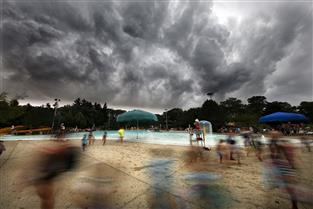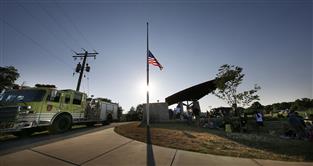City officials did a lot of big-picture thinking Feb. 28 at the Crowne Plaza Hotel, seeing in landlocked Wauwatosa enough opportunity to keep planners busy for years.
NAIOP, the Commercial Real Estate Development Association, sponsored this third annual event, and dozens of its members attended to hear a program of speakers who mixed past and present, and dreams and reality, followed by a meet-and-greet session.
"When I was elected, people asked me what my vision was for the city," Mayor Kathy Ehley said. "I find that interesting, because I don't think the vision of a city should be the vision of just one person."
Still, she offered one. Calling the city a "first-ring suburb," and an "urban suburb," Ehley evoked the dual nature of Wauwatosa.
"My vision is to keep the strong neighborhoods, still surviving, thriving, through all of the change that we're going through; to welcome business; to be thoughtful and prudent about how we grow … and still allowing the people who live here to feel that they have accessibility."
In Wauwatosa, attending a concert in Rotary Park, "it almost feels like Mayberry right in the middle of this incredible city. That's my vision."
Ehley said when she moved to Wauwatosa 40 years ago, "our community development director had a lot of extra time on his hands," and was able to help "put up snow-fencing for Tosafest."
Ehley said she was drawn to the city's sidewalks and porches and housing stock, "but I have to say, it was a little worn-out at that point." Car dealerships along Highway 100 were abundant, and "people were moving out to suburbs where they could find larger lots."
When the car dealerships started moving out to mega-dealerships, "suddenly we were a community with all this land, but we weren't a community with the structure to deal with economic development like that."
After a period of struggle, she said, "we really are at a point where we are open for business."
A developer's perspective
Ehley called the tax-incremental financing district that helped fund creation of the Milwaukee County Research Park "one of the most successful TIFs in the history of the state."
From a base property value of $4.4 million in 1995 when the TIF was created, the value had increased to $185 million by 2011, producing $4.3 million in additional property taxes last year.
Irgens has been a major player in the development of the park, and Dave Merrick, Irgens' vice president and marketing manager, said 12 projects have been completed in the park, with occupants such as GE Healthcare, Children's Hospital of Wisconsin, Johnson Controls, the Medical College of Wisconsin, United Healthcare and Zywave, among many others.
Growth in the park has been aided by a streamlined government approval process, requiring just the approval of the park by authority of its development agreement, without the need to seek specific endorsement by the city. The one-step process "is giving companies and developers confidence that deals could be done."
He praised the city-county effort to land GE Healthcare when it sought new quarters.
"The city of Wauwatosa put together an extremely competitive and creative financing package with multiple financing sources that were used to entice GE," he said.
The city purchased the land from Milwaukee County, and forged a long-term ground lease with Irgens, to reduce upfront costs.
The city also provided traditional TIF proceeds to support a multilevel parking structure to reduce project costs - a move that has become a point of contention and comparison in the deal involving ABB, for which the city has agreed to provide underground parking.
"Finally Wauwatosa provided a city-backed second mortgage at a lower interest rate than market that further bought down project costs," Merrick said.
"There's a pro-development climate within the local government," he said.
A contractor's view
"I see some of you are taking notes. If you write one thing down, remember this … Tosa Rocks!" said Robert Simi, vice president of business development for Miron Construction Co.
As chairman of the city's Economic Development Advisory Committee, he may not be the most objective observer.
Simi said he had two themes. The first, he said, "There's value in vision." And, second, "Vision creates demand."
His major example was University of Wisconsin-Milwaukee initiatives under former chancellor Carlos Santiago.
Pressed by decreasing funding from the state, Santiago conjectured that by turning UWM, historically a "commuter college," as Simi said, into a research center, he could increase revenue.
He chose the School of Freshwater Sciences, the Biomedical Sciences program and a new school for advanced engineering, to be built in Innovation Campus, as the drivers.
He presented his vision widely, and "he always ended his presentation by saying, 'But I have no land, and I have no money,' " Simi said, quoting Santiago.
"Fast forward nine years," Simi said. "the Freshwater Institute is being built for $50 million -brand new spanking boat to go along with it. You can hang out around Israel, you hang out around Singapore, and people are saying, 'Hey, that Milwaukee, they're like the freshwater capital of the world.
"Then all he does is go over to Wauwatosa and say, 'Hey I want to get that property, I want to get control of that northeast quadrant. Which all of us should know, or pretty much know, that it's not only the most valuable parcel in the area, it's pretty much the most valuable parcel in the state."
"He goes through the brain damage of getting it through the county, gets control of it, and now we're breaking ground in two weeks on the first building, the Accelerator building, and we're building roads. … They've got ABB, who can't get their building started fast enough, they've got another $50 (million) to $75 million interdisciplinary building planned. And we sit back and say, 'Does vision have value?' "
It's projects like this that create demand for the municipality, he said.
A planner's perspective
City Development Director Paulette Enders discussed recent restructuring of the city's development department and procedures to simply the development process.
She noted that development tends to occur "along the green belt that runs all throughout Wauwatosa," and went on to identify a number of opportunity areas. These were:
the former Harley-Davidson site;
the Burleigh Interchange area;
Mayfair mall and its outlots;
Mayfair Road generally;
North Avenue east and west;
East Tosa;
the four quadrants of the County Grounds;
the Village;
and State Street east of the Village.
More from News and Features
- Anodyne Coffee plans to open location in Wauwatosa Village
- Wauwatosa Meetings: Aug. 4
- Video: Wauwatosa girl's curbside ice cream stand raises money for the hungry
- Wauwatosa News and Notes: Hands-only CPR training offered; Firefly Art Fair is Aug. 6-7
- Wauwatosa Ask Now: Why are there barriers and fencing along the North Avenue bridges over the Menomonee River?
- Mystery Photo Contest: July 28
- Wauwatosa gears up for National Night Out event, this year at the zoo
- Election 2016: Wisconsin's 4th District candidates weigh in
- Wauwatosa's Luther Manor residents share smiles through flower delivery
- Wauwatosa Police Report: July 17-23














